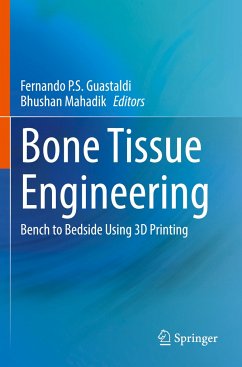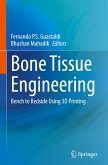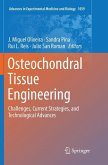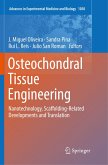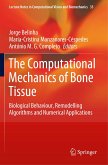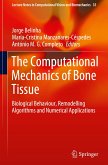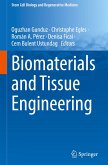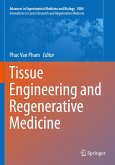Bone Tissue Engineering
Bench to Bedside Using 3D Printing
Herausgegeben:Guastaldi, Fernando P.S.; Mahadik, Bhushan
Bone Tissue Engineering
Bench to Bedside Using 3D Printing
Herausgegeben:Guastaldi, Fernando P.S.; Mahadik, Bhushan
- Broschiertes Buch
- Merkliste
- Auf die Merkliste
- Bewerten Bewerten
- Teilen
- Produkt teilen
- Produkterinnerung
- Produkterinnerung
This book provides a comprehensive overview of the state-of-the-art research as well as current challenges and strategies to reconstruct large bone defects employing 3D printing technology. Various topics covered include different 3D printing technologies that can be applied for bioengineering bone, the aspects of basic bone biology critical for clinical translation, tissue engineering platforms to investigate the bone niche microenvironment, the pathway to clinical translation, and regulatory hurdles.
Bone Tissue Engineering: State-of-the-Art in 3D Printing is an ideal book for students…mehr
Andere Kunden interessierten sich auch für
![Bone Tissue Engineering Bone Tissue Engineering]() Bone Tissue Engineering149,99 €
Bone Tissue Engineering149,99 €![Osteochondral Tissue Engineering Osteochondral Tissue Engineering]() Osteochondral Tissue Engineering149,99 €
Osteochondral Tissue Engineering149,99 €![Osteochondral Tissue Engineering Osteochondral Tissue Engineering]() Osteochondral Tissue Engineering112,99 €
Osteochondral Tissue Engineering112,99 €![The Computational Mechanics of Bone Tissue The Computational Mechanics of Bone Tissue]() The Computational Mechanics of Bone Tissue38,99 €
The Computational Mechanics of Bone Tissue38,99 €![The Computational Mechanics of Bone Tissue The Computational Mechanics of Bone Tissue]() The Computational Mechanics of Bone Tissue38,99 €
The Computational Mechanics of Bone Tissue38,99 €![Biomaterials and Tissue Engineering Biomaterials and Tissue Engineering]() Biomaterials and Tissue Engineering127,99 €
Biomaterials and Tissue Engineering127,99 €![Tissue Engineering and Regenerative Medicine Tissue Engineering and Regenerative Medicine]() Tissue Engineering and Regenerative Medicine149,99 €
Tissue Engineering and Regenerative Medicine149,99 €-
-
-
This book provides a comprehensive overview of the state-of-the-art research as well as current challenges and strategies to reconstruct large bone defects employing 3D printing technology. Various topics covered include different 3D printing technologies that can be applied for bioengineering bone, the aspects of basic bone biology critical for clinical translation, tissue engineering platforms to investigate the bone niche microenvironment, the pathway to clinical translation, and regulatory hurdles.
Bone Tissue Engineering: State-of-the-Art in 3D Printing is an ideal book for students and researchers interested in learning more about the latest advances in employing different 3D printing technologies for bone tissue engineering.
Bone Tissue Engineering: State-of-the-Art in 3D Printing is an ideal book for students and researchers interested in learning more about the latest advances in employing different 3D printing technologies for bone tissue engineering.
Produktdetails
- Produktdetails
- Verlag: Springer / Springer International Publishing / Springer, Berlin
- Artikelnr. des Verlages: 978-3-030-92016-6
- 1st edition 2022
- Seitenzahl: 332
- Erscheinungstermin: 9. März 2023
- Englisch
- Abmessung: 235mm x 155mm x 17mm
- Gewicht: 565g
- ISBN-13: 9783030920166
- ISBN-10: 303092016X
- Artikelnr.: 67486490
- Herstellerkennzeichnung Die Herstellerinformationen sind derzeit nicht verfügbar.
- Verlag: Springer / Springer International Publishing / Springer, Berlin
- Artikelnr. des Verlages: 978-3-030-92016-6
- 1st edition 2022
- Seitenzahl: 332
- Erscheinungstermin: 9. März 2023
- Englisch
- Abmessung: 235mm x 155mm x 17mm
- Gewicht: 565g
- ISBN-13: 9783030920166
- ISBN-10: 303092016X
- Artikelnr.: 67486490
- Herstellerkennzeichnung Die Herstellerinformationen sind derzeit nicht verfügbar.
Fernando P. S. Guastaldi is an Assistant Professor of Oral and Maxillofacial Surgery at Harvard School of Dental Medicine (HSDM) and Director of the Skeletal Biology Research Center (SBRC), Department of Oral and Maxillofacial Surgery (OMFS), Massachusetts General Hospital (MGH). He completed his DDS (2006) at the Dental School of Ribeirão Preto (Brazil). He is Specialist in OMFS (2010), and he completed is MSc (2010) and PhD (2013) in OMFS at the Dental School of Araçatuba (UNESP/Brazil). He was a Visiting Scholar (2012) at the Department of Biomaterials and Biomimetics at New York University College of Dentistry (NYUCD). He completed two Postdoctoral Research Fellowships, the first at the Dental School of Araraquara (UNESP/Brazil) (2014-2017) and the second at MGH/HSDM (2017-2019) focused on bone regeneration of swine mandible critical-sized defects by leveraging principles of tissue engineering and 3D printing. Dr. Guastaldi has research publications and book chapters inthe field of bone regeneration, maxillofacial reconstruction, and temporomandibular joint (TMJ) regeneration. Bhushan P. Mahadik is the Director of Tissue Engineering at Prellis Biologics. He completed his BS (2008) at the University of California, Berkeley, in chemical engineering and his MS (2010) and PhD 2014) at the University of Illinois at Urbana Champaign (UIUC) in chemical and biomolecular engineering. His PhD and postdoctoral research at UIUC focused on engineering the hematopoietic stem cell niche within the bone marrow by leveraging principles of biomaterial design and microfluidic platforms. He joined the University of Maryland in 2017 as the Assistant Director for the NIH/NIBIB Center for Engineering Complex Tissues (CECT), where he helped lead the research, collaborative, administrative, and strategic growth of CECT as a leading resource for the 3D printing and fabrication of engineered tissues. Dr. Mahadik has several research publications in the field of tissue engineering and regenerative medicine.
1. Introduction (market, clinical need, bone grafts) a. Choice 1: Alan S Herford, DDS, MD (Loma Linda University).- 2. Basic bone biology a. Choice 1: David T Scadden, MD (Massachusetts General Hospital).- 3. Principles of bone tissue engineering a. Choice 1: Antonios G Mikos, PhD (Rice University) b. Choice 2: Susmita Bose, PhD (Washington State University).- 4. Additive manufacturing technologies a. Choice 1: Anthony Atala, MD (Wake Forest School of Medicine) b. Choice 2: Jennifer A Lewis, ScD (Harvard University).- 5. 3D printing scaffolds for oral and maxillofacial regeneration a. Choice 1: Fernando PS Guastaldi, PhD (Massachusetts General Hospital) and Maria J Troulis, MsC (Massachusetts General Hospital).- 6. 3D printing scaffolds for orthopedic joint tissue engineering a. Choice 1: Anthony J Melchiorri, PhD (Rice University).- 7. 3D bioprinting and nanotechnology for bone tissue engineering a. Choice 1: Bhushan Mahadik, PhD (University of Maryland).- 8. Bioreactors and scale-up in bone tissue engineering a. Choice 1: John P Fisher, PhD (University of Maryland).- 9. Commercialization, legal, and regulatory considerations to translate 3D printing-based products to the marketplace and the clinic a. Choice 1: Anthony Ratcliffe, PhD (Synthasome, Inc.).- 10. Future directions and challenges a. Choice 1: James J Yoo, PhD (Wake Forest School of Medicine) b. Choice 2: Fernando PS Guastaldi, PhD (Massachusetts General Hospital) and Bhushan Mahadik, PhD (University of Maryland).
1. Introduction (market, clinical need, bone grafts) a. Choice 1: Alan S Herford, DDS, MD (Loma Linda University).- 2. Basic bone biology a. Choice 1: David T Scadden, MD (Massachusetts General Hospital).- 3. Principles of bone tissue engineering a. Choice 1: Antonios G Mikos, PhD (Rice University) b. Choice 2: Susmita Bose, PhD (Washington State University).- 4. Additive manufacturing technologies a. Choice 1: Anthony Atala, MD (Wake Forest School of Medicine) b. Choice 2: Jennifer A Lewis, ScD (Harvard University).- 5. 3D printing scaffolds for oral and maxillofacial regeneration a. Choice 1: Fernando PS Guastaldi, PhD (Massachusetts General Hospital) and Maria J Troulis, MsC (Massachusetts General Hospital).- 6. 3D printing scaffolds for orthopedic joint tissue engineering a. Choice 1: Anthony J Melchiorri, PhD (Rice University).- 7. 3D bioprinting and nanotechnology for bone tissue engineering a. Choice 1: Bhushan Mahadik, PhD (University of Maryland).- 8. Bioreactors and scale-up in bone tissue engineering a. Choice 1: John P Fisher, PhD (University of Maryland).- 9. Commercialization, legal, and regulatory considerations to translate 3D printing-based products to the marketplace and the clinic a. Choice 1: Anthony Ratcliffe, PhD (Synthasome, Inc.).- 10. Future directions and challenges a. Choice 1: James J Yoo, PhD (Wake Forest School of Medicine) b. Choice 2: Fernando PS Guastaldi, PhD (Massachusetts General Hospital) and Bhushan Mahadik, PhD (University of Maryland).

